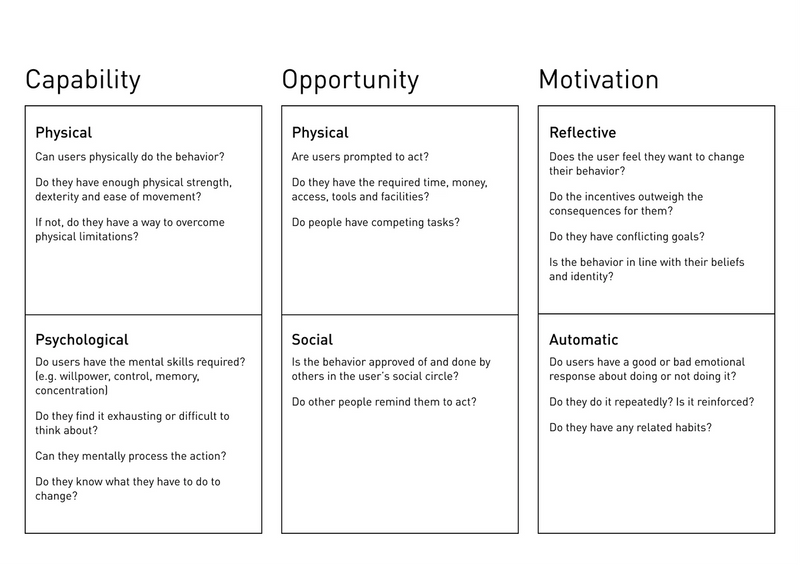COM-B: Change your user's behavior by asking the right questions.
3 min read
·
By Sonja Sarah Porter
·
December 10, 2021
People tend to see problems in terms of the solutions they themselves can deliver. For designers, this means that when a user problem or need arises we by default frame it as a problem we can solve with design. Say your customers want to save more money but they struggle setting aside money every month. How can we help them? As a digital product designer the answer is clear: this is a usability issue. The feature is too hidden or hard to use, so we need to make it frictionless to set up an automatic transfer to savings.
However, getting a person to do something (i.e. change their behavior) is much more complex than this. There are many factors that influence behavior (like saving money), interplaying with each other in unexpected ways. The COM-B model makes it easier to see this interplay by organizing factors into three major groups: Capability, Opportunity, and Motivation. According to COM-B, all of these needs must be met for a person to perform a certain behavior.

Unfortunately, because we are so focused on the problems our discipline can solve (for designers: creating the physical ability and opportunity) we miss the full picture of what is required for behavioral change. We cover one factor, but forget the rest – often leading to a frustrating lack of results.
So what can we do about it? As designers, we know how much the framing of a problem influences the way that we fix them. The questions we ask during research directly informs how we understand the problem, what issues we find, and what changes we suggest. Therefore it is important to ask questions that give us a full understanding of the barriers that block a user from behaving in a beneficial way. Take time during user interviews to ask about all the major factors from COM-B that can influence your target behavior. Continue to ask questions that reveal usability and communication issues… but also ask if they have social support. Maybe there is a salient emotional response, or a cognitive block like lack of concentration.

While improving information hierarchy or reducing clicks are often helpful measures, they aren’t always going to deliver results when your goal is actually behavioral change. Sometimes the answer is a policy change, or a marketing campaign. Behavioral change is complex and often requires a multidisciplinary approach. On the other hand, we as digital product designers have a unique position – we sit closest to insight on our user’s actual behavior. The key then lies in our ability to understand what is truly blocking the user from our target action, and letting this inform what changes we suggest to our teams and organizations. By taking a behavior-informed approach and using tools like the COM-B in our user interviews, we have a much higher chance of creating value and positive change for our users.